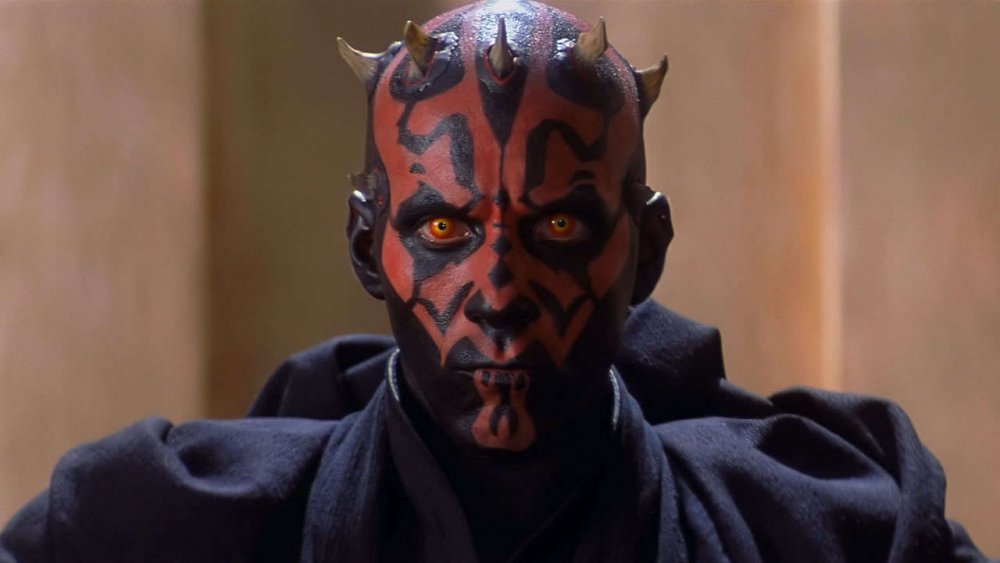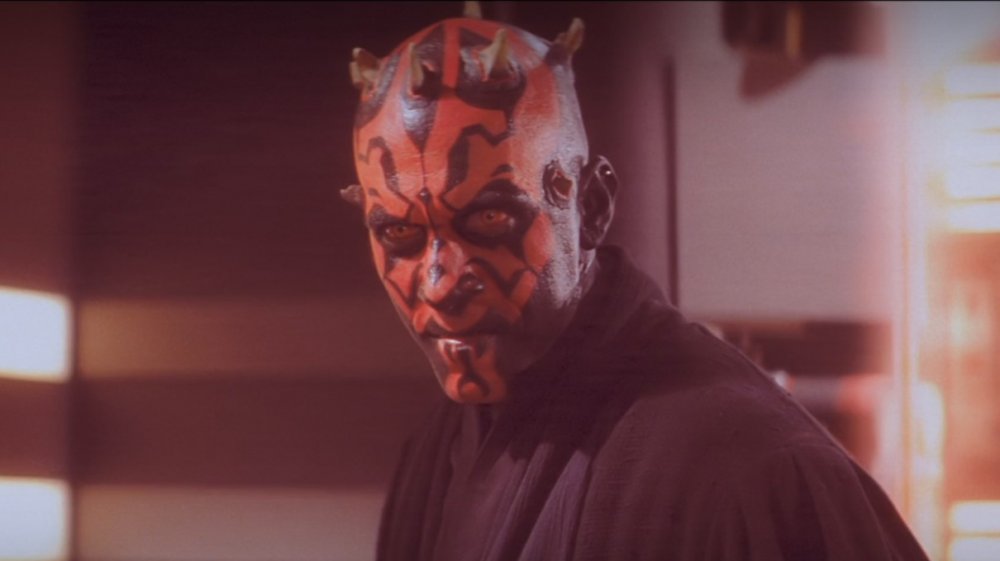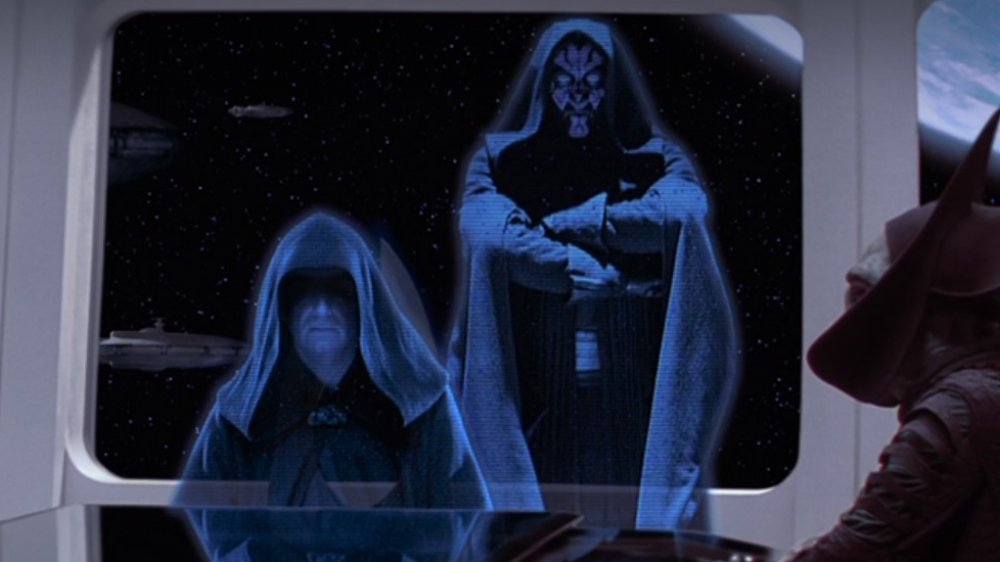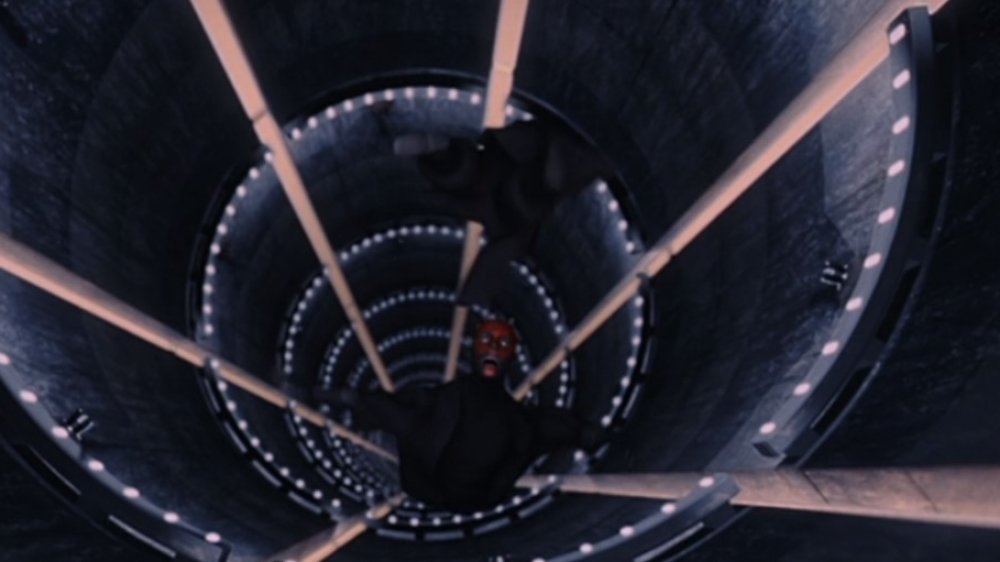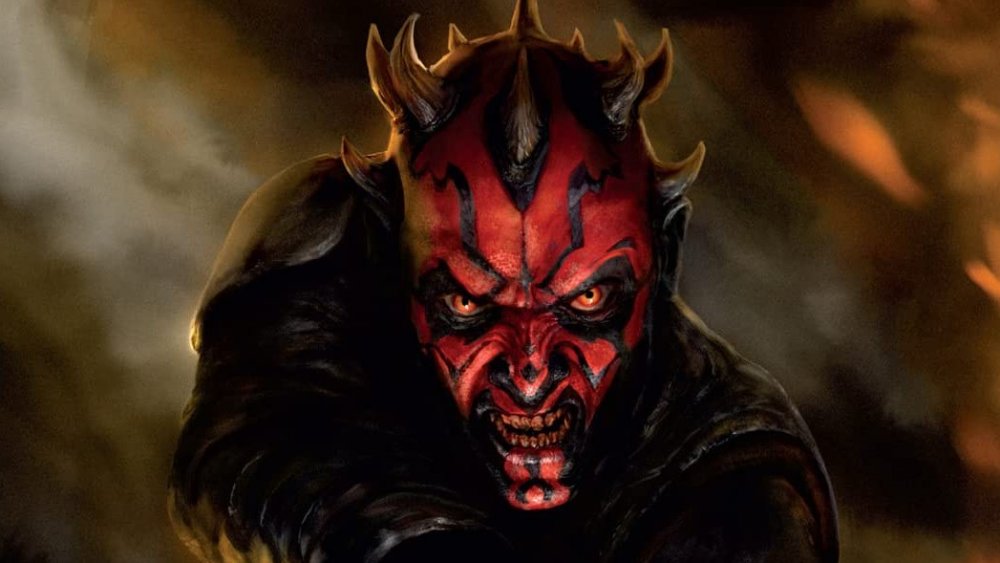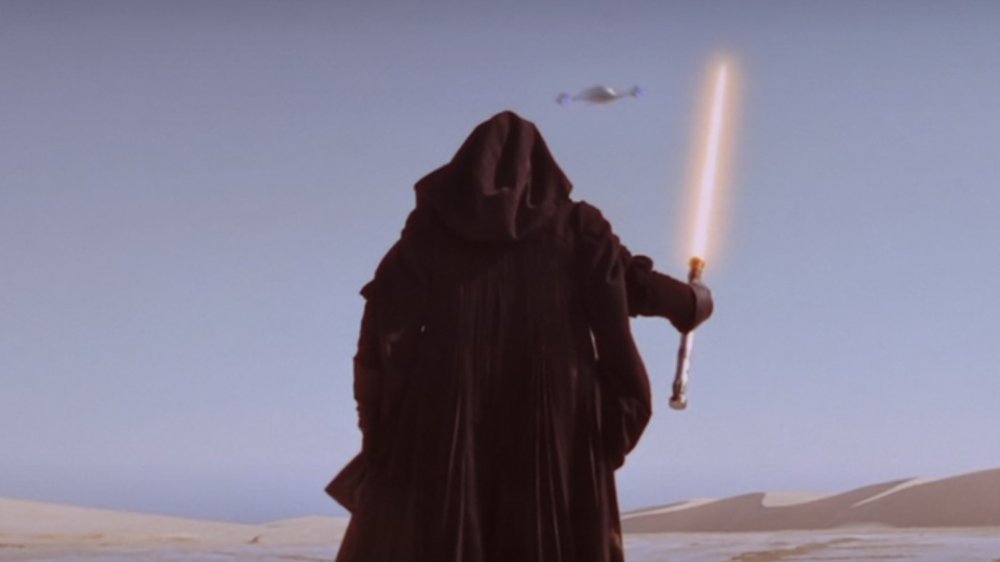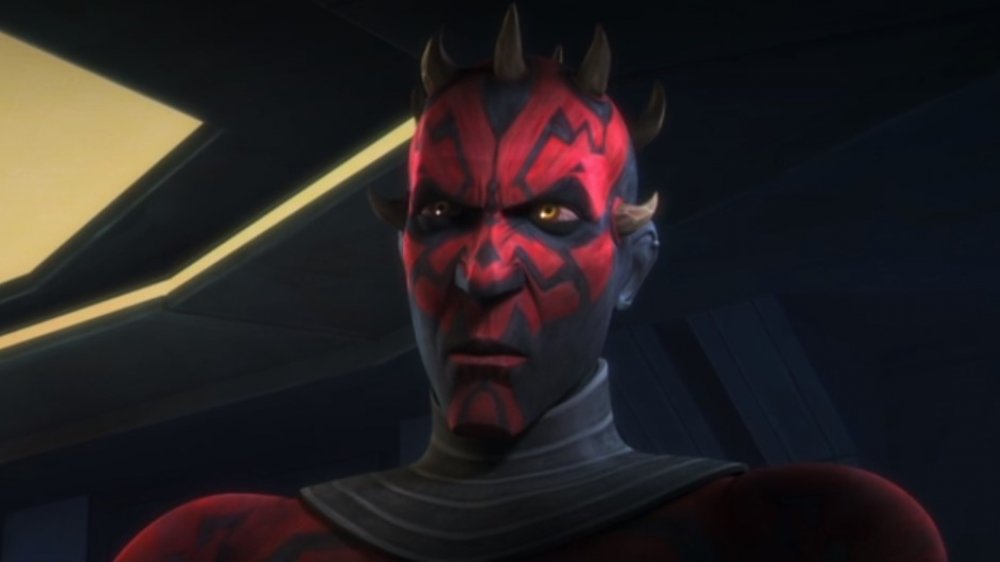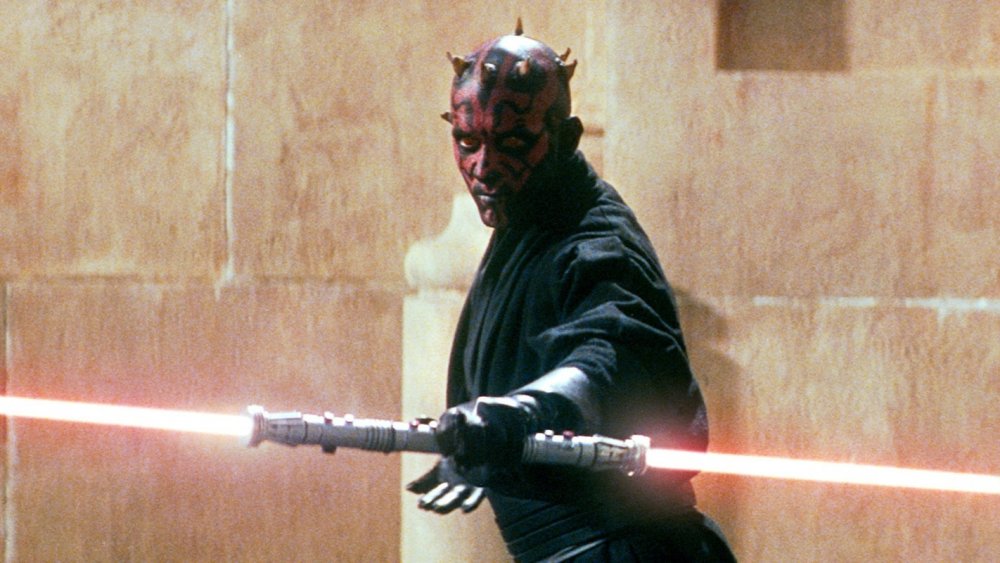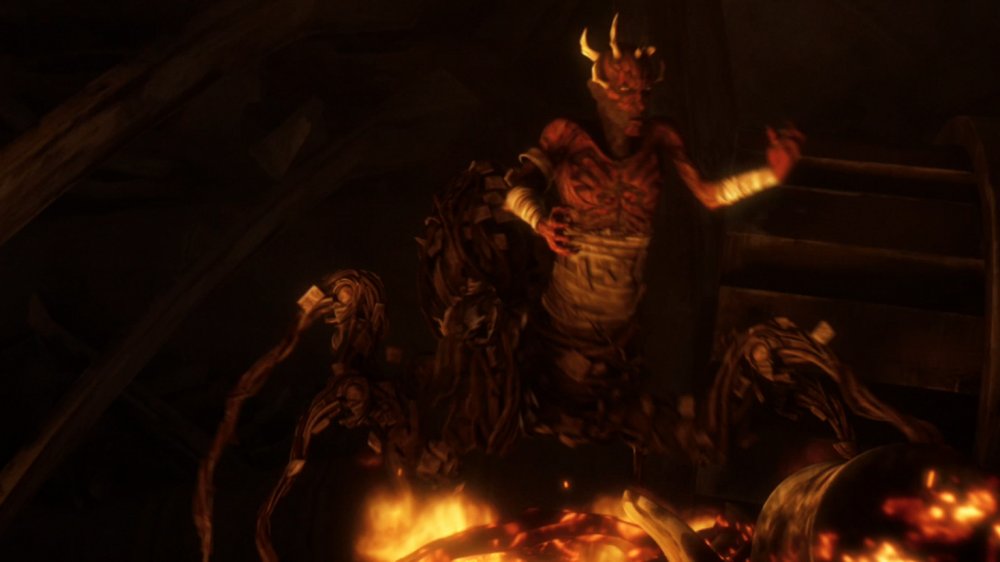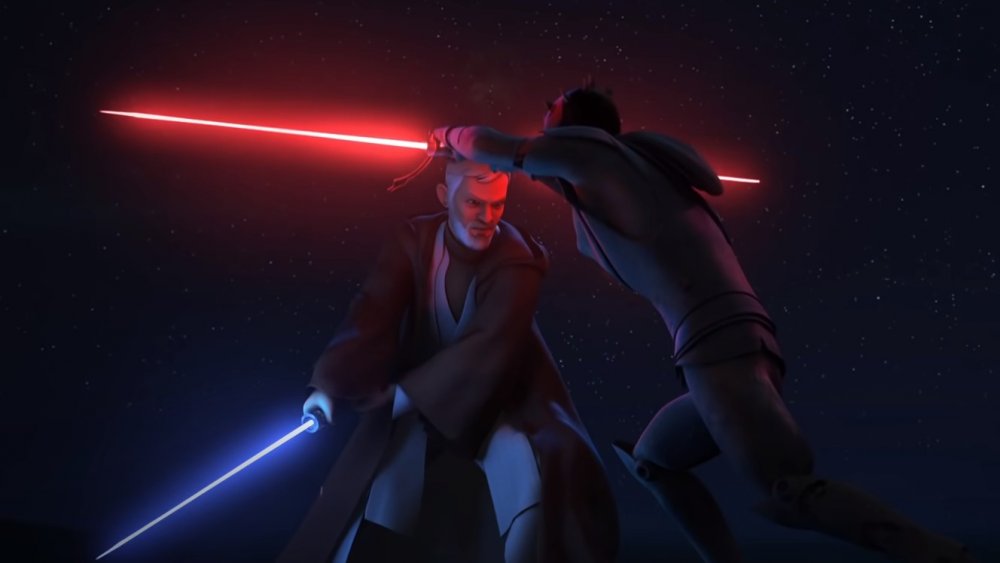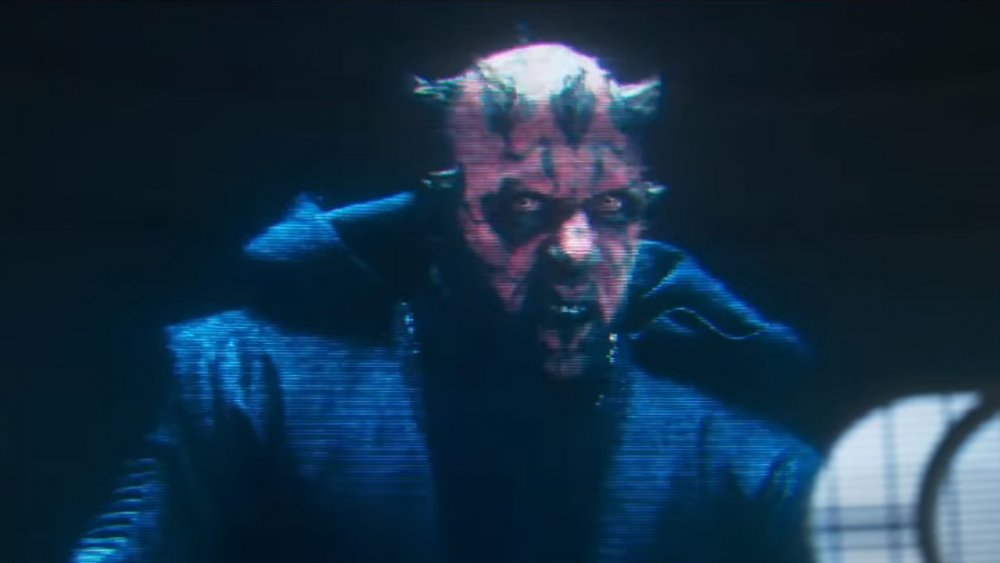Darth Maul Myths You Always Believed
"Through victory, my chains will be broken. The Force shall free me." So reads the final lines of the Sith code. Engraved on the very deepest part of every true Sith's heart is the desire to win, no matter the odds. And there are few faces or names that come to mind more readily when discussing the Sith than that of Darth Maul.
Darth Maul shocked audiences when they saw him on-screen in 1999's Episode I — The Phantom Menace. Unlike any Star Wars villain who'd come before, his terrifying visage and dark, billowing cloak told audiences right off the bat that this guy was majorly evil. Reminiscent of classical depictions of a devil or demon — with the spiky horns, red skin, haunting eyes, and terrifying, fang-like teeth — the designers didn't spare any expense in indicating that Darth Maul was, in fact, a bad guy.
Since his first appearance, he's quickly rocketed into fan-favorite status, inspiring wild theories and speculation. And some of those theories have worked their way into what's now held as common knowledge, but a lot of these beliefs simply aren't true. Looper is here to debunk these myths and set the record straight about one of the galaxy's greatest baddies.
Darth Maul is important and misunderstood
The Phantom Menace opens during a time of relative peace and prosperity for the galaxy and the sprawling systems that make up the Galactic Senate. But, as with any good story, there's trouble on the horizon. The Jedi Order has begun to feel disturbances in the Force, rumblings of the conflict which is to come.
Qui-Gon Jinn, the wise Jedi master, and his Padawan, Obi-Wan Kenobi, are some of the first to sense this disturbance, and as they race to complete their mission and avoid an all-out war between the systems, their path becomes dogged by ... well, by a phantom menace. That phantom? None other than Darth Maul. Darth Maul is responsible for setting into motion the events that spark the downfall of the Jedi order and bring down the Republic.
His integral role in the lore of Star Wars is why it's so important to get his backstory and the facts about him right, as these small details have large ripples on the greater universe of Star Wars, affecting everything from the dark criminal underbelly of some planets to the highest echelons of the ruling class on others. Like confusing Dantooine and Tatooine, getting Darth Maul's story wrong is a major Star Wars faux paus.
False: Darth Maul was Palpatine's first choice for apprentice
Such a spiky and intimidating guy as Darth Maul seems like an obvious choice for the apprentice for the ruler of an evil galactic empire, but he wasn't necessarily the first choice. Here's where Darth Maul's family comes into play.
Like most powerful men, Darth Maul had an even more powerful mother who raised him. Her name? The very casual moniker of Mother Talzin. She was the leader of the Nightsisters, a group of Force-sensitive Dathomirian women who used the power of the Force for their own purposes. Being that the Force imbues its users with seemingly otherworldly abilities, the Nightsisters were branded as witches.
Knowing of this powerful clan of Force users, Darth Sidious came to their home world of Dathomir, seeking an apprentice to teach the ways of the Sith and who would help him further his goals of ultimately bringing down the Galactic Republic and the Jedi Order. Originally, Sidious told Mother Talzin that he wanted her to be his apprentice. A powerful Force user in her own right, she seemed like a good choice.
But evil is as evil does, and Darth Sidious betrayed her. In a twisted mockery of the Jedi practice of teaching younglings, Sidious abducted her son, the young Darth Maul, and raised him in the ways of the Sith.
False: He died at the Battle of Naboo
Okay, here's the big one. If you've seen The Phantom Menace or maybe just a gif of Darth Maul getting chopped in half, you probably assumed that Darth Maul is dead. Getting chopped in half is a pretty hard injury to come back from ... for most that is.
In the Battle of Naboo, Qui-Gon Jinn and Obi-Wan Kenobi face off against the menace who's been nipping at their planet-hopping heels, Darth Maul himself. Qui-Gon Jinn battles Darth Maul alone and falls to the Sith's superior saber techniques. His Padawan, Obi-Wan Kenobi, then charges in with all the fury of the Force on his side. The Sith and the Jedi Master-in-training have an epic lightsaber battle, which ends in Darth Maul getting neatly sliced in half.
The gruesome image of his top half being severed from his legs definitely stuck in the minds of fans, who thought they'd seen the last of Maul. But as in so many movies and TV shows, falling into a misty, seemingly bottomless pit just doesn't mean much, even if you've been chopped in two. Years later, it was revealed that Darth Maul didn't die from his injuries that day. He used his powerful ties with the Force — as well as his sheer will combined with all-consuming hatred that had been nurtured and nourished by his Sith training — to cling to life.
Maul escaped through a garbage chute and was brought with the trash to a landfill planet, where he crudely constructed himself a set of robotic spider-like legs ... though he lost his mind in the process.
False: Darth Maul can come back as a Force ghost
It must've been pretty reassuring for Luke Skywalker the first time he heard his departed mentor Obi-Wan Kenobi's voice. After losing the good folks who raised him, the only home he'd ever known, and the man who introduced him to the space magic the Jedi call the Force, it was probably a big relief to know that there was a way for the dead to communicate with the living. Maybe he got all excited that he'd be able to finally talk to his real mom or other folks he'd lost.
What he may not have known is that only Jedi have this power. Oddly, being able to defy death is supposed to be the hallmark of the Sith. It's what initially attracted Anakin Skywalker to the dark side, after all. But it's true that only those who've devoted their lives to the light side of the Force can return as Force ghosts and party with or impart advice unto those still inhabiting the mortal realm.
In other words, Darth Maul could never have come back as a Force ghost. Sure, by the end of his long and exciting life, he wasn't a fan of the Sith, but the guy never embraced the light side of the Force. Anakin Skywalker, also known as Darth Vader, was able to return as a Force ghost because, in the end, he renounced evil and turned to the light. Darth Maul? He was bad to the bone until the day he died.
False: The term Sith was invented for The Phantom Menace
For many fans of Star Wars, the word "Sith" in Episode I: The Phantom Menace was a revelation. It was the first time many had heard the term codifying a name for what until then most had only heard referred to as "the dark side of the Force." It only made sense that there would be an evil and ominous order guarding the dark side as counterparts to the Jedi, guardians and protectors wielding the light side of the Force. And now, we finally knew their name.
But the history of the term Sith actually stretches back to the earliest days of Star Wars lore. Before Star Wars had rocked the world of pop culture and changed the face of cinema forever, it was all just whirling thoughts inside of the head of a young visionary/giant nerd, George Lucas. We think of characters like Luke Skywalker as being almost living people themselves because they seem so real and unchangeable. But these characters and the story surrounding them have undergone many drafts and revisions.
For example, the term "Sith" was actually first used in an early draft of A New Hope (via the Peter Mayhew Foundation). This was way back when the entire franchise was still in George Lucas' head as The Star Wars. While most of the changes and omissions in the final theatrical release of A New Hope were for the better, it's pretty cool that the Sith made their appearance decades later after, with Darth Maul hunting down our heroes.
False: Darth Maul is a member of the Sith species
When the concept of the Sith — a dark and violently evil counterpart to the righteous Jedi, fueled by greed and lust for power — was first introduced to audiences, fans went wild. Already familiar with the idea of the dark side of the Force, it was awesome to finally put a name to the mysterious order of dark Force wielders.
And as with so much of the massive, sprawling lore of Star Wars, there was so much more to uncover. In the Star Wars universe, the term "Sith" originates from an ancient race of Force-sensitive humanoids hailing originally from the planet Korriban. They themselves were known as the Sith, and the entire race had a penchant for the dark side. If that sounds like a pretty intense place to live ... it was! This Force-wielding race eventually became dispersed and scattered throughout the galaxy, and the name of their once mighty civilization was used to refer to the order of Force users who allied with the dark side.
The Sith had dark red skin and bodies with bone spur protrusions, not too dissimilar to Darth Maul. But while he was one of the first beings to be associated with the word Sith, he isn't actually a Sith himself, species-wise. He hails from the planet Dathomir, which also is full of Force-sensitive peoples, though they're divided into different societies based on gender. His true species name is Zabrak, not Sith like many at first supposed.
False: His lightsaber uses a red Kyber crystal
There's nothing more emblematic of a warrior aligned with the Force, be it dark side or light side, than a lightsaber. These weapons of pure Force energy have become wildly popular with fans worldwide, and the lore surrounding them is complex and fascinating.
As part of a Jedi's training as a Padawan learner (an apprentice to a Jedi master), they learn to build their own lightsaber, and the true power of these swords comes from something known as a Kyber crystal. These crystals can be found throughout the galaxy, on various worlds and in various sizes and densities. They're used to focus Force energy, giving the lightsaber its blade. The reason they're so precious to the Jedi and the Sith is that these crystals are naturally attuned to the Force.
When a young Jedi finds the right Kyber crystal to craft their lightsaber, they'll meditate with the crystal, aligning themselves to it, until it takes on a unique color. But when a Sith builds a lightsaber, it's a much more violent business. They'll steal the Kyber crystal from a defeated Jedi and meditate with it, seeking to break its connection with the light side and turn it to the dark side of the Force. This process is known as "bleeding" the crystal, and it gives the Sith weapons their distinctive red hue. So if you were wondering how Darth Maul's dual lightsaber got that particular color, now you know.
False: Darth Maul was a dedicated Sith for his whole life
Taken from his homeworld and everything he knew at a young age, Darth Maul was trained by one of the most powerful Sith lords the galaxy had ever known. Darth Sidious molded Maul to be a deadly living weapon and tool of the dark side. Such training and brainwashing would be difficult to break away from, and it seemed at first that Darth Maul was a loyal Sith until the day he died. But this wasn't the case.
After his defeat at the Battle of Naboo, Darth Maul fell into madness. Clinging to life by sheer will, hatred, and his alignment with the dark side, he lost his sanity, though he was still cunning and talented enough to craft himself a new lower half of spider-like legs. After he was rescued by his brother and given a better set of mechanical limbs, Maul had his mind set on only one thing: revenge against Kenobi.
But with Darth Sidious in charge of the Sith, the law of the order was the rule of two. There could only be one master and one apprentice. And Darth Vader was now the apprentice. Maul was no longer a Sith. However, he used his Force powers and his prowess in battle to set himself up as a crime lord, becoming the shadow power behind the ruler of the planet Mandalore.
False: Obi-Wan and Darth Maul only battled once
Whether it was lurking in exile, trying on a new set of robotic legs, or building a new crime empire, Maul never lost sight of his one, true, burning motivation — revenge against the man who'd bested him and literally split him in two.
Obi-Wan Kenobi had faced off against Maul at the Battle of Naboo and won. Though he was still a Padawan, Kenobi was able to beat Maul, sending him spiraling into seeming doom. The battle was epic, a lightsaber duel for the ages. Of course, Darth Maul was probably exhausted from just having battled and killed Obi-Wan's master, Qui-Gon Jinn. This may have contributed to Obi-Wan's success, though time would prove him to be one of the greatest, if not the greatest, Jedi to have ever lived. It seemed like this would be the last time the two would ever meet, as their encounter ended with Maul being chopped in half, after all. But years later, the two would have a final showdown.
Though they wove in and out of each other's lives during the Clone Wars and beyond, it would be on Tatooine, the place of their first fight, where Maul would meet his final doom at the hands of Kenobi. Years after the fall of the Galactic Republic, Maul traced Kenobi to his desert hideout, where the Jedi kept a watchful eye on a growing Luke Skywalker. They would cross sabers once again, and the outcome would be the same, with Kenobi triumphant ... this time for good.
False: His face markings are part of his species' natural appearance
The signature facial markings of Darth Maul set him apart from any other villain in the Star Wars movies. They fascinated fans and cosplayers across the world and inspired much speculation and imitation. Being that Maul was the first member of his species introduced to audiences in the movies, and given the fact that the facial markings look organic and like they could absolutely be a naturally occurring phenomenon, many fans thought that the black, Rorschach-like stripes were simply a part of his species. Much like the ring of horns or his haunting eyes, we all just assumed that this was just a hallmark of whatever race Maul hailed from.
But when more about his origin story was revealed, fans learned that he's a Dathomirian Zabrak, and we learned that others of his species had similar markings. But on Dathomir, the planet he hails from, these markings are actually tattoos, given to young male warriors ... very young in fact. Darth Maul was given his tattoos before his first birthday, by his mother, the leader of the Nightsisters.
